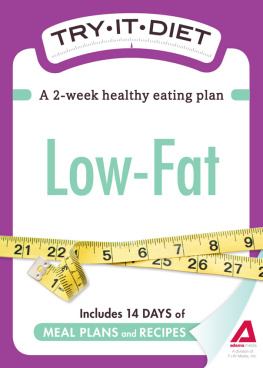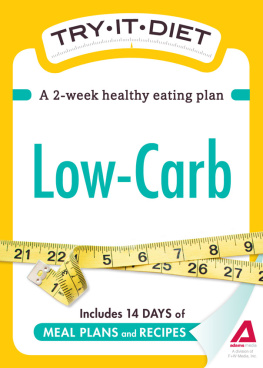
Try-It Diet: Glycemic Index Diet
A two-week healthy eating plan
Adams Media, an imprint of Simon & Schuster, Inc.

Avon, Massachusetts
Contents
Introduction
A Try-It Diet is just that a diet that you can try out for two weeks to see if it is a good fit for you. Keep in mind that not every diet is right for every person; please consult with your doctor before making radical changes to your diet. There are many reasons for using the glycemic index (GI). The glycemic index has been studied for decades and was originally developed as a dietary strategy in the treatment of diabetes. Today, use of the glycemic index has expanded, and it is now used in the treatment of many common health concerns, including obesity and heart disease. Because it teaches a healthy and balanced way of eating, the GI also has a role in disease prevention.
The glycemic index is a simple and valuable tool that can be used to help choose the right carbohydrate foods to keep blood sugar levels stable. It is based on a numerical index that ranks foods based on their glycemic response in the body. Lower GI foods are more slowly digested and absorbed and, therefore, produce gentler fluctuations in blood sugar and insulin levels. Higher glycemic index foods cause a quicker rise in blood sugar and insulin. Knowing how to choose the right carbohydrate foods, plan balanced meals, and select the right portion sizes are the keys to weight control, disease prevention, and overall good health. The glycemic index levels of foods have been determined by tests performed by scientists in clinical settings.
This is done by feeding human test subjects a determined portion of the test food and drawing and testing samples of their blood at specific intervals of time. The test subjects blood sugar response to a carbohydrate food is compared to the blood sugar response to an equal portion of pure glucose. Glucose, which has a GI level of 100, is the reference food for glycemic index testing. For example, if orange juice is being tested and is found to raise the blood sugar level only 50 percent as much as pure glucose, orange juice is given a glycemic index level of 50. Based on its GI level, a food can be assigned to one of three GI categories: low, moderate, and high glycemic index. It is healthy to eat a wide variety of low-glycemic foods while minimizing higher-glycemic foods.
A diet that follows the glycemic index can be beneficial for everyone. This is not a restrictive diet that eliminates major food groups or pushes expensive supplements. Using the GI is a simple way to start eating better now. People with diabetes, metabolic syndrome, and those interested in weight management have a lot to gain from implementing the principles of the glycemic index in their lifestyle. However, a GI diet is not just for those with special health needs; it is a healthy and balanced way of eating for anyone who wants to take care of his or her body, feel good, and experience longevity. The primary goal of a diet that follows the glycemic index is to minimize and prevent insulin-related health problems such as diabetes, heart disease, and being overweight by avoiding foods with the largest impact on blood sugar.
By keeping blood sugar levels stable, insulin levels remain constant. A low GI diet is often recommended for individuals who are at risk for developing diabetes because of its role in reducing insulin fluctuations. Eating foods that cause large and fast glycemic response may lead to an initial quick surge in energy, shortly followed by a decrease in blood sugar, which results in lethargy, hunger, mood swings, and fat storage. Replacing high GI foods with low GI foods helps to sustain energy levels throughout the day. A low GI diet that prevents the ups and downs in blood sugar and insulin helps achieve appetite control and mood stability while preventing weight gain. Being well-prepared by keeping low glycemic index foods stocked in the pantry will have you on your way to eating a low GI diet.
Go shopping at the market ahead of time to gather the ingredients needed for the recipes. There are certain ingredients and staple items that you will notice in many of the recipes. It is a good idea to keep these items in stock so you will have a GI-friendly kitchen. Some of these ingredients include agave nectar or syrup, almond flour, whole-wheat flour, olive oil, balsamic vinegar, red wine vinegar, whole-wheat pasta, brown rice, nuts, canned and dry beans, Italian seasoning, garlic, flaxseeds, soy sauce, and Dijon mustard. Low GI foods include:
- Nonstarchy vegetables, such as lettuce, broccoli, spinach, onion, and green beans
- Most fruits, including stone fruits, apples, berries, cherries, and citrus fruits
- Nuts, beans, seeds, and legumes
- Plain, unsweetened yogurt and cheese (choose low-fat or nonfat when possible)
- Minimally processed whole grains, such as steel-cut oats, brown rice, whole-wheat and sprouted grain breads, granola and muesli, and whole-wheat pasta
Although following the glycemic index is a beneficial way of eating, other factors play an important role in health, longevity, and weight control. The total amount of calories consumed should be considered when planning meals.
Understanding serving sizes for portion control will help you become a better judge of how much food to put on your plate. In addition to eating right, regular physical activity is a necessary part of a balanced lifestyle. Exercise helps burn excess calories that may otherwise be stored as body fat. If youd like to explore the Glycemic Index Diet in more detail, check out The Everything Glycemic Index Cookbook, 2nd Edition, available in print (ISBN: 978-1-4405-0584-3) and eBook (eISBN: 978-1-4405-0585-0) formats.
Weekly Meal Plans
Week 1
Sunday
Breakfast
Lunch
Dinner
Dessert
Monday
Breakfast
Lunch
Snack
Dinner
Tuesday
Breakfast
Lunch
Snack
Dinner
Wednesday
Breakfast
Lunch
Snack
Dinner
Thursday
Breakfast
Lunch
Snack
Dinner
Friday
Breakfast
Lunch
Snack
Dinner
Saturday
Breakfast
Lunch
Dinner
Dessert
Week 2
Sunday
Breakfast
Lunch
Dinner
Dessert
Monday
Breakfast
Lunch
Snack
Dinner
Tuesday
Breakfast
Lunch
Snack
Dinner
Wednesday
Breakfast
Lunch
Snack
Dinner
Thursday
Breakfast
Lunch
Next page




















 Avon, Massachusetts
Avon, Massachusetts